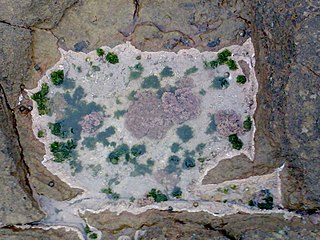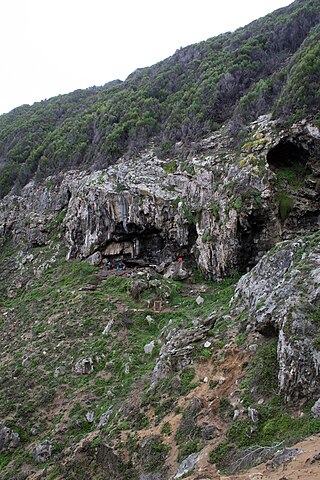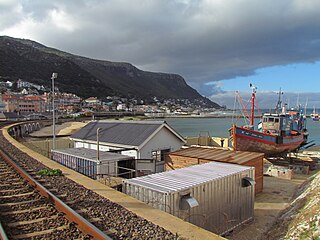Cave Bay may refer to:
Cave Bay may refer to:

A cave or cavern is a natural void in the ground, specifically a space large enough for a human to enter. Caves often form by the weathering of rock and often extend deep underground. The word cave can refer to smaller openings such as sea caves, rock shelters, and grottos, that extend a relatively short distance into the rock and they are called exogene caves. Caves which extend further underground than the opening is wide are called endogene caves.

A microclimate is a local set of atmospheric conditions that differ from those in the surrounding areas, often slightly but sometimes substantially. The term may refer to areas as small as a few square meters or smaller or as large as many square kilometers. Because climate is statistical, which implies spatial and temporal variation of the mean values of the describing parameters, within a region there can occur and persist over time sets of statistically distinct conditions, that is, microclimates. Microclimates can be found in most places but are most pronounced in topographically dynamic zones such as mountainous areas, islands, and coastal areas.

Gower or the Gower Peninsula is in South West Wales and is the most westerly part of the historic county of Glamorgan, Wales. It projects towards the Bristol Channel. In 1956, the majority of Gower became the first area in the United Kingdom to be designated an Area of Outstanding Natural Beauty.

Hạ Long Bay or Halong Bay is a UNESCO World Heritage Site and popular travel destination in Quảng Ninh province, Vietnam. The name Hạ Long means "descending dragon". Administratively, the bay belongs to Hạ Long city, Cẩm Phả city, and is a part of Vân Đồn district. The bay features thousands of limestone karsts and islets in various shapes and sizes. Hạ Long Bay is a center of a larger zone that includes Bai Tu Long Bay to the northeast, and Cát Bà Island to the southwest. These larger zones share a similar geological, geographical, geomorphological, climate, and cultural characters.

Egg Harbor is a town in Door County, Wisconsin, United States. The population was 1,194 at the 2000 census. The Village of Egg Harbor and the unincorporated community of Carlsville are located within the town. The Town of Egg Harbor was hit by an F3 tornado in 1998.

Positano is a village and comune on the Amalfi Coast, in Campania, Italy, mainly in an enclave in the hills leading down to the coast.

Cemaes is a village on the north coast of Anglesey in Wales, sited on Cemaes Bay, an Area of Outstanding Natural Beauty which is partly owned by the National Trust. It is the most northerly village in Wales. The name Cemaes derives from the Welsh word cemais, meaning "bend or loop in a river, inlet of sea, bay". In 2011 the population of Cemaes in Llanbadrig community was 1,357. The most northerly point in Wales, Ynys Badrig, is nearby.

Franchthi Cave or Frankhthi Cave is an archaeological site overlooking Kiladha Bay, in the Argolic Gulf, opposite the village of Kiladha in southeastern Argolis, Greece.

Fish Hoek is a coastal town at the eastern end of the Fish Hoek Valley on the False Bay side of the Cape Peninsula in the Western Cape, South Africa. Previously a separate municipality, Fish Hoek is now part of the City of Cape Town. As a coastal suburb of Cape Town, Fish Hoek is popular as a residence for commuters, retired people and holidaymakers alike. The traditional industries of 'trek' fishing and angling coexist with the leisure pursuits of surfing, although nearby Kommetjie is usually favoured, sailing and sunbathing. There is an active lifeguard community who utilise the beach and bay for training.

Blombos Cave is an archaeological site located in Blombos Private Nature Reserve, about 300 km east of Cape Town on the Southern Cape coastline, South Africa. The cave contains Middle Stone Age (MSA) deposits currently dated at between c. 100,000 and 70,000 years Before Present (BP), and a Late Stone Age sequence dated at between 2000 and 300 years BP. The cave site was first excavated in 1991 and field work has been conducted there on a regular basis since 1997, and is ongoing.
The Stillbay industry was named by archaeologists A. J. H. Goodwin and C. van Riet Lowe in 1929, and is a Middle Stone Age stone tool manufacturing style after the site of Stilbaai in South Africa where it was first described. It may have developed from the earlier Acheulian types. In addition to Acheulian stone tools, bone and antler picks were also used.

Kalk Bay is a fishing village and suburb of Cape Town. It lies on the east coast of False Bay with much of the town built on the slopes of mountains which border the sea, with peaks of Table Mountain Sandstone forming valleys. The railway from Cape Town to Simon's Town passes through Kalk Bay, which has one station near the harbour.

Weeki Wachee Springs is a natural tourist attraction located in Weeki Wachee, Florida, where underwater performances by "mermaids," women wearing fish tails as well as other fanciful outfits, can be viewed in an aquarium-like setting in the spring of the Weeki Wachee River. A waterpark, Buccaneer Bay, river boat rides, kayak and paddleboard rental are some of the other activities offered at Weeki Wachee Springs.
Carnage is a synonym for a massacre, meaning the killing of a large number of people.
Shannon may refer to:

Nereo Cave is a huge underwater sea-cave situated on the north-west of Sardinia in the Coral riviera of Alghero, Italy. The name was given by the discoverers in honour of the mythological figure Nereus, who is often billed as the Old Man of the Sea, father of the Nereids. The site is under the high limestone cliffs of Capo Caccia, 100 metres north of the famous Neptune's Grotto.
Portbraddon Cave is a relict sea cave located near Portbraddon, County Antrim on the north coast of Northern Ireland. Its location 5 m (16 ft) above the present-day high water mark makes it important archaeologically, as it would have been inhabited as far back as the Mesolithic.

Nelson Bay Cave also known as Wagenaar's Cave is a Stone Age archaeological site located in the Robberg Nature Reserve on the Robberg Peninsula and facing Nelson's Bay near Plettenberg Bay in South Africa, and showing evidence of human occupation as far back as 125,000 years ago.
In classical antiquity the god Pan was often venerated in caves. In the present these caves are often referred to as the Cave of Pan.
Elands Bay Cave is located near the mouth of the Verlorenvlei estuary on the Atlantic coast of South Africa's Western Cape Province. The climate has continuously become drier since the habitation of hunter-gatherers in the Later Pleistocene. The archaeological remains recovered from previous excavations at Elands Bay Cave have been studied to help answer questions regarding the relationship of people and their landscape, the role of climate change that could have determined or influenced subsistence changes, and the impact of pastoralism and agriculture on hunter-gatherer communities.